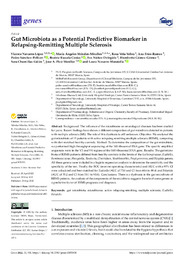Por favor, use este identificador para citar o enlazar este ítem:
https://hdl.handle.net/11000/36542Registro completo de metadatos
| Campo DC | Valor | Lengua/Idioma |
|---|---|---|
| dc.contributor.author | navarro-lopez, vicente | - |
| dc.contributor.author | MENDEZ MIRALLES, MARIA ANGELES | - |
| dc.contributor.author | Vela-Yebra, Rosa | - |
| dc.contributor.author | Fríes Ramos , Ana | - |
| dc.contributor.author | Sánchez Pellicer, Pedro | - |
| dc.contributor.author | Ruzafa-Costas, Beatriz | - |
| dc.contributor.author | Núñez-Delegido, Eva | - |
| dc.contributor.author | Gómez-Gómez, Humberto | - |
| dc.contributor.author | Chumillas, Sara | - |
| dc.contributor.author | Pico-Monllor, JOSE ANTONIO | - |
| dc.contributor.author | Navarro-Moratalla, Laura | - |
| dc.contributor.other | Departamentos de la UMH::Farmacología, Pediatría y Química Orgánica | es_ES |
| dc.date.accessioned | 2025-05-02T08:40:54Z | - |
| dc.date.available | 2025-05-02T08:40:54Z | - |
| dc.date.created | 2022-05-23 | - |
| dc.identifier.citation | Genes 2022, 13(5), 930 | es_ES |
| dc.identifier.issn | 2073-4425 | - |
| dc.identifier.uri | https://hdl.handle.net/11000/36542 | - |
| dc.description.abstract | Background: The influence of the microbiome on neurological diseases has been studied for years. Recent findings have shown a different composition of gut microbiota detected in patients with multiple sclerosis (MS). The role of this dysbiosis is still unknown. Objective: We analyzed the gut microbiota of 15 patients with active relapsing-remitting multiple sclerosis (RRMS), comparing with diet-matched healthy controls. Method: To determine the composition of the gut microbiota, we performed high-throughput sequencing of the 16S ribosomal RNA gene. The specific amplified sequences were in the V3 and V4 regions of the 16S ribosomal RNA gene. Results: The gut microbiota of RRMS patients differed from healthy controls in the levels of the Lachnospiraceae, Ezakiella, Ruminococcaceae, Hungatella, Roseburia, Clostridium, Shuttleworthia, Poephyromonas, and Bilophila genera. All these genera were included in a logistic regression analysis to determine the sensitivity and the specificity of the test. Finally, the ROC (receiver operating characteristic) and AUC with a 95% CI were calculated and best-matched for Ezakiella (AUC of 75.0 and CI from 60.6 to 89.4) and Bilophila (AUC of 70.2 and CI from 50.1 to 90.4). Conclusions: There is a dysbiosis in the gut microbiota of RRMS patients. An analysis of the components of the microbiota suggests the role of some genera as a predictive factor of RRMS prognosis and diagnosis. | es_ES |
| dc.format | application/pdf | es_ES |
| dc.format.extent | 13 | es_ES |
| dc.language.iso | eng | es_ES |
| dc.publisher | MDPI | es_ES |
| dc.rights | info:eu-repo/semantics/openAccess | es_ES |
| dc.rights | Attribution-NonCommercial-NoDerivatives 4.0 Internacional | * |
| dc.rights.uri | http://creativecommons.org/licenses/by-nc-nd/4.0/ | * |
| dc.subject | gut microbiota | es_ES |
| dc.subject | microbiome | es_ES |
| dc.subject | active relapsing-remitting multiple sclerosis | es_ES |
| dc.subject | Ezakiella | es_ES |
| dc.subject | Bilophila | es_ES |
| dc.title | Gut Microbiota as a Potential Predictive Biomarker in Relapsing-Remitting Multiple Sclerosis | es_ES |
| dc.type | info:eu-repo/semantics/article | es_ES |
| dc.relation.publisherversion | https://doi.org/10.3390/genes13050930 | es_ES |

Ver/Abrir:
Gut Microbiota as a Potential Predictive Biomarker in.pdf
1,69 MB
Adobe PDF
Compartir:
 La licencia se describe como: Atribución-NonComercial-NoDerivada 4.0 Internacional.
La licencia se describe como: Atribución-NonComercial-NoDerivada 4.0 Internacional.
.png)